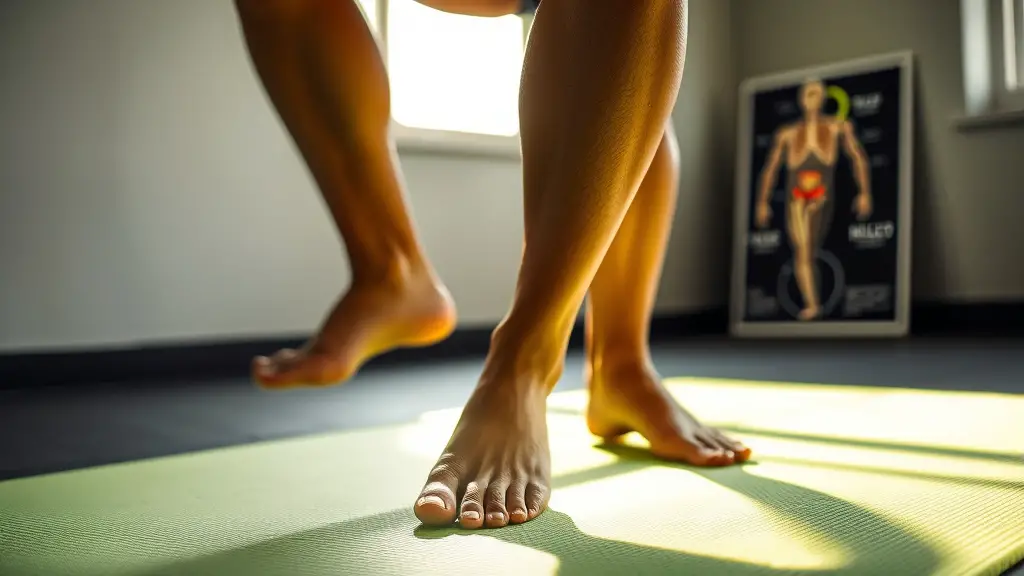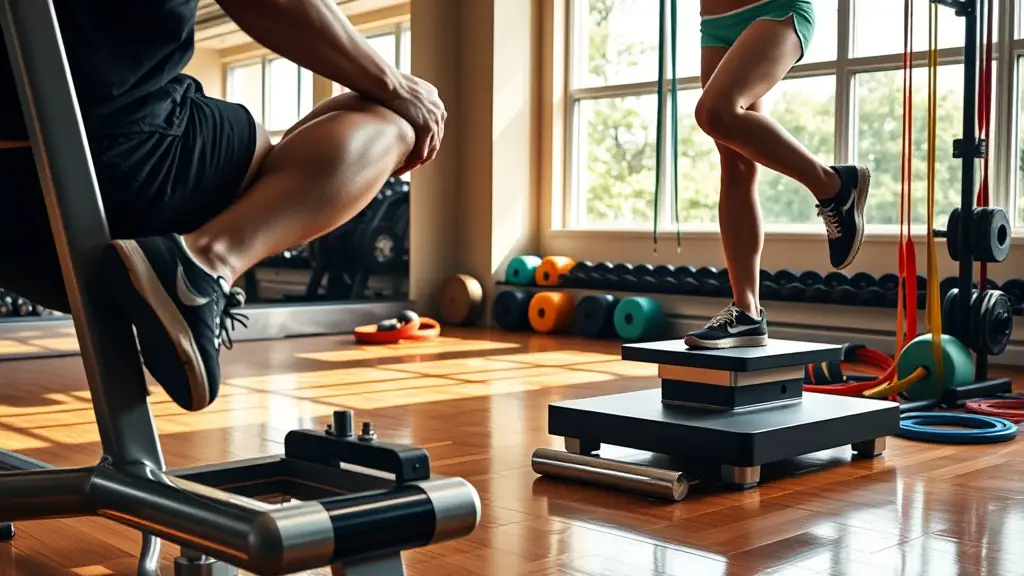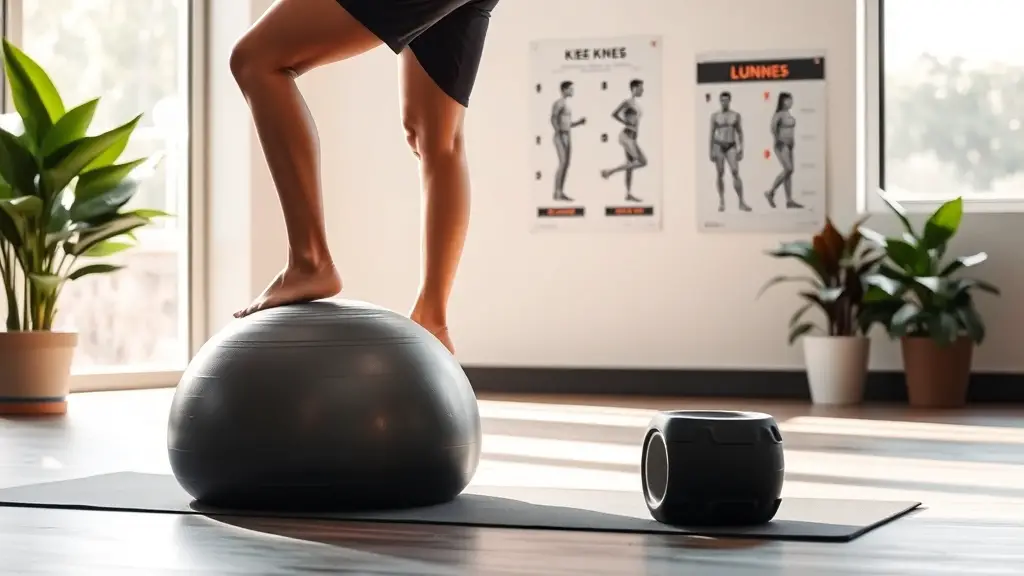The Best Exercises to Strengthen Your Knees and Prevent Injury

To strengthen your knees and prevent injuries, focus on key exercises like straight leg raises, wall sits, and squats for your quadriceps. Incorporate hamstring curls and calf raises to guarantee balanced strength. Don’t skip balance exercises such as single-leg stands and lateral lunges for stability. Always warm up properly and include stretching techniques post-workout to enhance flexibility. Prioritizing these methods will keep your knees healthy and functional. Keep exploring to discover even more strategies for ideal knee care.
Understanding Knee Anatomy and Function

When you consider the complexity of your knee, it’s easy to see why understanding its anatomy and function is fundamental for effective strengthening. The knee joint structure consists of bones, cartilage, ligaments, and tendons, all working together to facilitate movement. The femur, tibia, and patella form the primary bones, while the menisci act as shock absorbers. This intricate setup allows for flexion and extension, vital for activities like walking and running.
Understanding knee movement mechanics helps you appreciate how different muscles, such as the quadriceps and hamstrings, contribute to stability and mobility. When these muscles are strong and balanced, they support the knee joint, reducing the risk of injury. Recognizing the relationship between the knee’s anatomy and its function empowers you to make informed decisions about your strengthening regimen, ensuring that you target the right areas for peak performance and protection.
Importance of Knee Strengthening Exercises
Knee strengthening exercises play an essential role in preventing injuries by enhancing the stability and resilience of your joints. By focusing on these exercises, you can also improve your athletic performance, allowing for better agility and power during physical activities. Prioritizing knee strength not only supports your current fitness level but also safeguards your long-term mobility.
Injury Prevention Benefits
Strengthening your knees is essential for preventing injuries, especially if you’re active in sports or daily activities. Strong knees enhance your overall knee health by supporting the joint and surrounding muscles, which can greatly lower your injury risk. Weakness in the knee region often leads to instability, increasing the likelihood of strains, sprains, or even tears. By incorporating targeted exercises, you build resilience in your knees, allowing them to better absorb impact and resist stress. Additionally, strengthening these muscles helps with proper alignment, reducing undue pressure on the joint. Investing time in knee-strengthening exercises isn’t just about performance; it’s a proactive approach to safeguard your mobility and guarantee you can enjoy your activities for years to come.
Enhanced Athletic Performance
Strong knees not only help prevent injuries but also play a significant role in enhancing athletic performance. When you focus on knee-strengthening exercises, you’ll find improvements in your overall capabilities. Here are three key benefits:
- Increased Power: Strong knees support explosive movements, allowing you to excel in speed training and plyometric drills.
- Improved Stability: Enhanced knee strength stabilizes your body during dynamic activities, reducing the risk of falls and improving coordination.
- Better Endurance: Strengthened knees help you maintain performance levels over longer periods, enabling you to push through fatigue during competitions.
Warm-Up Exercises for Knee Health

Before diving into more intense workouts, it’s essential to warm up properly to protect your knees and enhance overall performance. Start with dynamic stretching, which increases blood flow and prepares your muscles for action. Exercises like leg swings and walking lunges can greatly improve joint mobility, ensuring your knees are ready for the demands ahead.
Incorporate hip circles and ankle rolls to engage the surrounding joints and reduce stiffness. Spend at least 5 to 10 minutes on these activities, focusing on controlled movements that promote flexibility.
Additionally, consider incorporating light cardio, such as brisk walking or cycling, to elevate your heart rate while keeping your knees engaged. This thorough warm-up routine not only boosts your performance but also minimizes the risk of injury. By prioritizing these warm-up exercises, you’re setting yourself up for a safer and more effective workout session. Remember, maintaining proper technique during your warm-up can significantly enhance knee health and stability.
Quadriceps Strengthening Exercises
While your knees bear a considerable amount of weight during daily activities, it’s essential to strengthen the quadriceps to support and stabilize this important joint. Enhancing quadriceps activation directly impacts knee joint biomechanics, reducing injury risk and improving overall function. Here are three effective exercises to target your quadriceps:
Strengthening your quadriceps is vital for knee stability and reducing injury risk during daily activities.
- Straight Leg Raises: Lie on your back and raise one leg while keeping it straight. Hold for a few seconds, then lower it. Repeat on both sides.
- Wall Sits: Slide down a wall into a sitting position with your knees at a 90-degree angle. Hold for 20-30 seconds, focusing on engaging your quadriceps.
- Squats: Stand with feet shoulder-width apart, lower your body as if sitting in a chair, and push through your heels to return to standing.
Incorporating these exercises into your routine can greatly enhance your knee stability and strength.
Hamstring and Calf Strengthening Exercises

Strengthening your hamstrings and calves is essential for maintaining knee stability and overall lower body function. Neglecting these muscles can lead to imbalances, increasing your risk of injury. Hamstring curls are a fantastic exercise to isolate and strengthen the hamstrings. You can perform them using a resistance band or a machine; just guarantee you maintain proper form to maximize effectiveness and avoid strain.
Calf raises are equally important, targeting the gastrocnemius and soleus muscles. Stand on the edge of a step or flat surface, lifting your heels to engage the calves. You can do this exercise with added weights for increased resistance. Aim for three sets of 10-15 repetitions for both hamstring curls and calf raises, gradually increasing intensity as your strength improves. By consistently incorporating these exercises into your routine, you’ll build a solid foundation that supports your knees during daily activities and athletic pursuits.
Balance and Stability Exercises for the Knees
After you’ve built a solid foundation with hamstring and calf strengthening exercises, it’s important to incorporate balance and stability exercises into your routine. These exercises not only enhance your overall knee stability but also play a vital role in injury prevention. By engaging in balance training and stability drills, you can improve your proprioception and coordination, ultimately leading to stronger knees.
Here are three effective exercises to take into account:
- Single-Leg Stand: Stand on one leg for 30 seconds, gradually increasing the duration as you improve. This helps strengthen the stabilizing muscles around your knees.
- Balance Board Squats: Perform squats on a balance board to challenge your stability. This exercise mimics real-life movements and enhances knee control.
- Lateral Lunges: Step to the side into a lunge, focusing on maintaining balance. This drill targets the muscles supporting your knees from different angles.
Incorporate these into your routine for ideal knee health!
Stretching and Recovery Techniques for Knee Maintenance

To maintain ideal knee health, it’s vital to prioritize stretching and recovery techniques that support flexibility and reduce tension in the surrounding muscles. Incorporating foam rolling into your routine can be highly advantageous. This self-myofascial release technique helps break down knots and improve blood flow, making your muscles more pliable and less prone to injury. Spend a few minutes rolling your quadriceps, hamstrings, and calves to guarantee peak muscle recovery.
In addition to foam rolling, static stretching is essential. After your workouts, take the time to perform stretches targeting your hamstrings, quadriceps, and calves. Hold each stretch for 20-30 seconds to enhance flexibility and promote muscle relaxation. These techniques not only aid in recovery but also help prevent tightness that could lead to knee discomfort. Furthermore, practicing proper technique during exercises like jumping rope can significantly enhance knee stability and reduce injury risk. By integrating these practices into your routine, you’ll greatly contribute to the long-term health and stability of your knees.
Frequently Asked Questions
How Long Should I Rest After a Knee Injury?
Imagine you’re a knight, resting after a battle. After a knee injury, you should generally rest for at least 48 to 72 hours to allow swelling to decrease. The recovery timeline varies based on the injury’s severity; mild sprains may heal in a week, while more serious injuries could take several weeks. Listen to your body, and don’t rush back into action too soon. Proper rest is essential for long-term health and strength.
Can I Strengthen My Knees Without Equipment?
Yes, you can definitely strengthen your knees without equipment. Bodyweight exercises like squats, lunges, and step-ups are effective in building strength. Incorporating flexibility training, such as stretching your quadriceps and hamstrings, can also improve your knee health. Remember to focus on proper form to avoid strain. Gradually increase the intensity of your workouts, listen to your body, and give yourself time to recover. It’s all about consistency and patience for ideal results.
What Are Common Knee Injuries to Watch For?
Knee injuries can feel like the end of the world when you’re active. Common ones to watch for are knee sprains and ligament tears, which can happen from sudden movements or overuse. A sprain stretches or tears the ligaments, causing pain and instability, while ligament tears, like the ACL tear, can lead to significant dysfunction. It’s crucial to recognize these injuries early to prevent further damage and guarantee proper recovery.
When Should I Consult a Doctor About Knee Pain?
If you’re experiencing persistent knee pain that lasts more than a few days, it’s wise to contemplate a doctor consultation. Additionally, if the pain is accompanied by swelling, inability to bear weight, or a popping sound, don’t hesitate to seek professional help. Early intervention can prevent further damage and guarantee you receive the appropriate treatment. Remember, your knee health is vital, and addressing issues promptly can lead to better long-term outcomes.
Are There Age-Specific Exercises for Knee Strength?
Yes, there are age-specific exercises for knee strength. For youth, it’s beneficial to focus on dynamic stretches and bodyweight exercises that promote flexibility and strength, like squats and lunges. In contrast, senior exercises should emphasize low-impact activities, such as swimming or cycling, alongside gentle strength training to maintain joint health without excessive strain. Tailoring exercises to your age helps guarantee safety while effectively strengthening your knees and preventing injuries.





